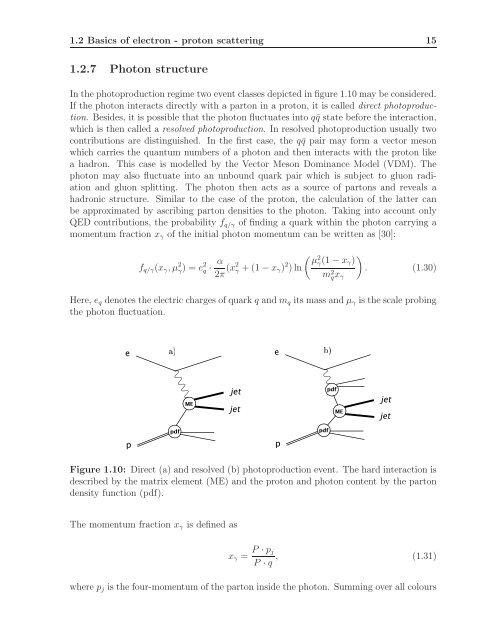10 - H1 - Desy
10 - H1 - Desy
10 - H1 - Desy
Create successful ePaper yourself
Turn your PDF publications into a flip-book with our unique Google optimized e-Paper software.
1.2 Basics of electron - proton scattering 15<br />
1.2.7 Photon structure<br />
In the photoproduction regime two event classes depicted in figure 1.<strong>10</strong> may be considered.<br />
If the photon interacts directly with a parton in a proton, it is called direct photoproduction.<br />
Besides, it is possible that the photon fluctuates into q¯q state before the interaction,<br />
which is then called a resolved photoproduction. In resolved photoproduction usually two<br />
contributions are distinguished. In the first case, the q¯q pair may form a vector meson<br />
which carries the quantum numbers of a photon and then interacts with the proton like<br />
a hadron. This case is modelled by the Vector Meson Dominance Model (VDM). The<br />
photon may also fluctuate into an unbound quark pair which is subject to gluon radiation<br />
and gluon splitting. The photon then acts as a source of partons and reveals a<br />
hadronic structure. Similar to the case of the proton, the calculation of the latter can<br />
be approximated by ascribing parton densities to the photon. Taking into account only<br />
QED contributions, the probability f q/γ of finding a quark within the photon carrying a<br />
momentum fraction x γ of the initial photon momentum can be written as [30]:<br />
f q/γ (x γ , µ 2 γ) = e 2 q · α<br />
2π (x2 γ + (1 − x γ ) 2 ) ln<br />
( µ<br />
2<br />
γ (1 − x γ )<br />
m 2 q x γ<br />
)<br />
. (1.30)<br />
Here, e q denotes the electric charges of quark q and m q its mass and µ γ is the scale probing<br />
the photon fluctuation.<br />
" A4?A4 " G; 2G D !6K
















